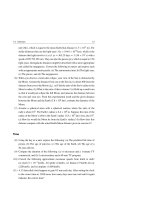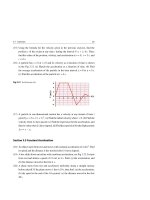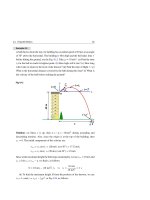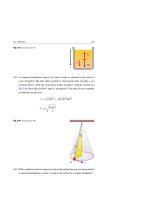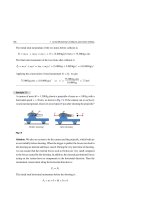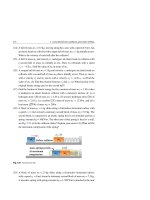Hafez a radi, john o rasmussen auth principles of physics for scientists and engineers 15
Bạn đang xem bản rút gọn của tài liệu. Xem và tải ngay bản đầy đủ của tài liệu tại đây (569.31 KB, 30 trang )
10.5 Fluid Dynamics
337
Example 10.18
Flow Speed from a Reservoir (Torricelli’s Law). A tank is filled with water to
a height y1 = 3.5 m. The tank has a small hole in one of its walls at a height
y2 = 1.5 m, see Fig. 10.27. (a) What is the speed v2 of the water emerging from
the hole? (b) What is the horizontal distance x from the base of the tank to the
point at which the water stream strikes the floor?
Fig. 10.27
y
y1
Pa
0
h y1 - y2
Pa
y2
0
x
Solution: (a) The pressure at the top of reservoir and at the hole is the atmospheric
pressure Pa , because both of them are exposed to the atmosphere. If we assume
the tank has a large cross-sectional area A1 compared to that of the hole’s, i.e.
A1 A2 , then water at the top of the reservoir will be almost stationary, i.e. v1 0.
In addition to this, h = y1 − y2 . Using Bernoulli’s equation, see Eq. 10.38, we get:
Pa + 21 ρ × (0) + ρgy1 = Pa + 21 ρv22 + ρgy2
v2 =
That is:
Thus:
v2 =
2gh =
⇒
v22 = 2gh
2gh
2(9.8 m/s2 )(2 m) = 6.26 m/s
The relation v2 = 2gh is the same as that for an object falling freely from rest
through a height h. This is known as Torricelli’s law.
(b) As in Sect. 4.3, the initial water velocity v→o ≡ v→2 is horizontal (i.e. θ◦ = 0)
and the initial position is y◦ ≡ y2 = 1.5 m. Since water strikes the floor at y = 0,
then we use y − y◦ = (v◦ sin θ◦ ) t − 21 g t 2 to first find the duration of descent for
the water as follows:
338
10 Mechanical Properties of Matter
0 − 1.5 m = 0 −
1
2
(9.8 m/s2 ) t 2
⇒
t = 0.553 s
The horizontal distance x covered by the water in that time is:
x = (v◦ cos θ◦ ) t = (6.26 m/s)(cos 0◦ )(0.553 s) = 3.46 m
Example 10.19
In the Venturi meter of Fig. 10.28, air of density ρair = 1.3 kg/m3 flows from
left to right through a horizontal pipe of radius r1 = 1.25 cm that necks down
to r2 = 0.5 cm. The U-shaped tube of the meter contains mercury of density
ρmer = 13.6 × 103 kg/m3 . If the speed of the air entering the meter is v1 = 10 m/s,
then find the mercury-level difference h between the two arms.
A1
Air flow
A2
1
r1 r2
2
P2
P1
h
Mercury
Fig. 10.28
Solution: Since the air moves horizontally, then Bernoulli’s equation at the two
openings of the U-shaped tube becomes:
P1 − P2 = 21 ρair (v22 − v12 )
Also, from the continuity Eq. 10.32 we have:
A1 v1 = A2 v2
⇒
v2 = v1
π r2
A1
= v1 12 = v1
A2
π r2
r1
r2
2
Substituting with the form of v2 in the pressure difference, we get:
P1 − P2 = 21 ρair v12
r1
r2
4
−1
10.5 Fluid Dynamics
339
The pressure difference between the two openings of the U-shaped tube produces
a mercury-level difference h given by P1 − P2 = ρmer gh. Thus, by combining the
last result with this equation we get:
h=
ρair v12
2ρmer g
r1 4
(1.3 kg/m3 )(10 m/s)2
−1 =
r2
2(13.6 × 103 kg/m3 )(9.8 m/s2 )
1.25 cm 4
−1
0.5 cm
= 0.019 m = 1.9 cm
∗ Example 10.8
The sketch in Fig. 10.29 shows a perfume atomizer before and after compressing
its bulb. When the bulb is compressed gently, air with density ρair flows steadily
through a narrow tube, reducing the pressure at the position of the vertical tube.
Liquid of density ρL can rise in this vertical tube and enter the horizontal tube and
be sprayed out. If the pressure in the bulb is Pa + P, where Pa is the atmospheric
pressure, and v2 is the speed of air in the horizontal tube, then find the pressure
formula in the horizontal tube. What must the value of v2 be in order to raise the
liquid to the horizontal tube?
Air
Pa
Air flow
P2
P1 = Pa + P
Pa
Bulb
Air
Pa
Liquid
h
1
0
Compressed bulb
Before
2
Pa
h
Liquid
After
Fig. 10.29
Solution: By applying Bernoulli’s equation on the bulb and the narrow horizontal
tube we get the following:
(Pa + P) + 21 ρ × (0) = P2 + 21 ρair v22
That is:
P2 = Pa + P − 21 ρair v22
340
10 Mechanical Properties of Matter
So, the decrease in P2 depends on the square of the speed v2 .
When the liquid rises a distance h to the horizontal tube, we have:
Pa = P2 + ρL gh
By equating the expression of P2 from the last two results we get:
P2 = Pa + P − 21 ρair v22 = Pa − ρL gh
Thus:
v2 =
2(P + ρL gh)
ρair
Viscosity
Fluids cannot withstand a shearing stress. However, fluids show some degree of
resistance to shearing motion, and this resistance is called viscosity.
The degree of viscosity can be understood by considering a fluid between two
sheets of glass where the lower one is kept fixed; see the sketch in Fig. 10.30. It is
easier to slide the upper glass if the fluid is oil as opposed to tar because tar has a
higher viscosity than oil.
F
d
c
y
f
F
e
Δx
d
At time t+ Δ t
At time t
a
b
a
b
Fig. 10.30 A fluid between two sheets of glass where the lower one is kept fixed while the upper one
moves to the right with a speed v under the action of an external force of magnitude F
We can think of fluids as a set of adjacent layers. Thus, a reasonable shearing stress
produces smooth relative displacement of adjacent layers in fluids, called laminar
flow. When we apply a force of magnitude F to the upper glass of area A, it will
move to the right with a speed v. As a result of this motion, a portion of the fluid
with shape abcd will take a new shape abef after a short time interval
t.
10.5 Fluid Dynamics
341
According to Sect. 10.2, we can define the shearing stress and the shearing strain
on the fluid of Fig. 10.30 as follows:
Shearing stress =
F
,
A
Shearing strain =
x
d
(10.41)
Since the upper sheet is moving with speed v,the fluid just beneath it will move with
the same speed. Thus, in time t, the fluid just beneath the upper sheet moves a
distance x = v t. Accordingly, we define the rate of shear strain as:
Rate of shear strain =
shear strain
=
t
x/d
v
=
t
d
(10.42)
By analogy to the shear modulus in solids, we define in fluids, at a given temperature,
the ratio of the shear stress to the rate of shear strain. This ratio, η, is known as the
coefficient of viscosity or simply the viscosity:
η=
F/A
Fd
=
v/d
Av
(10.43)
The SI unit of viscosity is N.s/m2 = Pa.s which is called the poiseuille (abbreviated
by Pl) while in cgs it is dyne.s/cm2 which is called the poise (abbreviated by P). Thus,
1 N.s/m2 = 1 Pa.s = 1 Pl = 10 P = 103 cP.
Table 10.6 depicts some viscosity values.
Table 10.6 The viscosity of some fluids at specific temperatures
Fluid
Temperature T (◦ C)
Viscosity η (N.s/m2 = Pl)
Benzene
20
0.07 × 10−3
Water
100
0.3 × 10−3
Water
20
1 × 10−3
Whole blood
37
2.7 × 10−3
10-wt Motor oil
30
250 × 10−3
Glycerin
20
830 × 10−3
∗
Equation 10.43 is valid only when the velocity of the fluid varies linearly with
the perpendicular distance to the fluid velocity. In this case, it is common to say
that the velocity gradient is uniform. In case of non-uniform velocity gradient, the
viscosity has the general form:
η=
F/A
dv/dy
(10.44)
342
10 Mechanical Properties of Matter
Stokes’ law
The drag force of a small object that moves with a low speed v through a viscous
medium was given in Sect. 5.2 of Chap. 5 by the relation FD = bv, where b is a
proportionality constant.
When the small object is a sphere of radius r and it moves with a terminal speed
vt through a viscous medium with viscosity η, it experiences a drag force Fvis which
by Stokes’ law has a magnitude:
Fvis = 6π ηrvt
(10.45)
As an application to Stokes’ formula, Fig. 10.31 displays the fall of a small metallic
spherical ball of volume Vs = 43 π r 3 , density ρs , and mass ms = Vs ρs in a viscous
liquid of density ρ. The forces that act on the sphere when it reaches its terminal
(constant) speed vt will be:
1. The sphere’s weight W = ms g = ρs Vs g (downwards)
2. The buoyant force FB = ρ V g (upwards)
3. The viscous force Fvis = 6π ηrvt (upwards)
Fig. 10.31 A small sphere
falling with terminal speed vt
in a liquid of density ρ and
viscosity η
Fvis
FB
t
ms g
y
We must equate the volume of the liquid V that was displaced by the sphere with
the volume of the falling sphere Vs . Thus:
ms g = FB + Fvis
⇒
ρs Vs g = ρ Vs g + 6π ηrvt
From this equation we get the following relation for the viscosity η:
η=
2 (ρs − ρ)r 2 g
9
vt
(10.46)
10.5 Fluid Dynamics
343
Example 10.21
A steel plate of area A = 0.2 m2 is placed over a thin film of lubricant of thickness
d = 0.4 mm sprayed over the flat horizontal surface of a table, see Fig. 10.32.
When connected via a cord that passes over a massless and frictionless pulley to a
mass m = 10 g, the steel plate is found to move with a constant speed v = 0.05 m/s.
Find the viscosity of the lubricant oil.
Fig. 10.32
A
Fv is
= constant
T
d
T
Lubricant
mg
Solution: Since the steel plate moves with a constant speed, its resultant force
must be zero. Thus, the magnitude of the tension force must equal the magnitude
of viscous force exerted by the lubricant on the plate, i.e. Fvis = T . Also, the
magnitude of the tension in the cord is equal to the magnitude of the suspended
weight, i.e. T = m g. Thus:
Fvis = T = mg = (10 × 10−3 kg)(9.8 m/s2 ) = 9.8 × 10−2 N
The layer of lubricant in contact with the horizontal surface of the table is at
rest. The lubricant speed increases across the film, reaching a maximum, v, at the
layer in contact with the steel plate which moves with speed v. If we assume that
the rate of shear strain is constant, i.e. the velocity gradient is uniform, then we
can use Eq. 10.43 to evaluate the viscosity as follows:
η=
Fvis d
(9.8 × 10−2 N)(0.4 × 10−3 m)
Fvis /A
=
=
v/d
Av
(0.2 m2 )(0.05 m/s)
= 3.92 × 10−3 N.s/m2 = 3.92 cP
344
10 Mechanical Properties of Matter
Example 10.22
A tiny glass sphere of density ρs = 2.6 × 103 kg/m3 falls with a terminal velocity vt through oil which has a density ρ = 950 kg/m3 and a viscosity coefficient
η = 0.2 N.s/m2 . It is experimentally observed that the sphere drops a distance
d = 20 cm between the two points A and B in time t = 50 s, see Fig. 10.33. Find
the radius r of the glass sphere.
Fig. 10.33
A
t=0
t
d
B
t
t
Solution: From experimental observations, the terminal speed of the sphere will
be given by:
vt =
d
20 × 10−2 m
=
= 4 × 10−3 m/s
t
50 s
The forces that act on the sphere when it reaches its terminal (constant) speed
vt will be: the sphere’s weight W = ms g = ρs Vs g (downwards), the buoyant
force FB = ρ V g (upwards), and the viscous force Fvis = 6π ηrvt (upwards), see
Fig. 10.34. The volume of the liquid V that was displaced by the sphere equals the
volume of the falling sphere, i.e. V = Vs = 43 π r 3 . Since the sphere moves with
constant speed vt , its resultant force must be zero. Thus:
ρs Vs g = ρ Vs g + 6π ηrvt
Solving for the sphere’s radius, we obtain:
r=
9ηvt
=
2(ρs − ρ)g
9(0.2 N.s/m2 )(4 × 10−3 m/s)
2(2.6 × 103 kg/m3 − 950 kg/m3 )(9.8 m/s2 )
= 4.7 × 10−4 m = 0.47 mm
10.6 Exercises
345
Fig. 10.34
Fvis
FB
t
10.6
ms g
Exercises
Section 10.1 Density and Relative Density
(1) A solid cube of mass of 0.04 kg has a side of length 1 cm. What is the density
and the specific gravity of the cube?
(2) A solid sphere has a radius of 1 cm and a mass of 0.04 kg. What is the density
and the specific gravity of the sphere?
(3) Lead bricks like the one in Fig. 10.35 are used to shield people from the hazards
of radioactive materials. If the lead density is ρ = 11.36 × 103 kg/m3 , then find
the mass and weight of such a brick.
Fig. 10.35 See Exercise (3)
5 cm
20 cm
10 cm
Section 10.2 Elastic Properties of Solids
(4) A mass of 5 kg is suspended from the end of a copper wire that has a diameter
of 1 mm. Find the tensile stress on the wire?
(5) A 4 m long structural steel rod with a cross-sectional area of 0.5 cm2 stretches
1 mm when a mass of 250 kg is hung from its lower end. Find the value of
Young’s modulus for this steel.
(6) An iron rod 10 m long and 0.5 cm2 in cross section, stretches 2.5 mm when
a mass of 300 kg is hung from its lower end. Find Young’s modulus for the
iron rod.
(7) A wire has a length L = 3 m and a radius r = 0.75 cm, see Fig. 10.36.
A force acting normally on each of its ends has a magnitude F⊥ = 9 × 104 N.
346
10 Mechanical Properties of Matter
Find the change in the wire’s length and radius, when its Young’s modulus
Y is 190 × 109 N/m2 and its Poisson’s ratio μ is 0.25.
Fig. 10.36 See Exercise (7)
A
r
F⊥
Initial
shape
r _ | Δr |
Final
shape
L
F⊥
L+Δ L
(8) A uniform platform is suspended by four wires, one on each corner. The wires
are 2-m long and have a radius of 1 mm, and their material has a Young’s
modulus Y = 190 × 109 N/m2 . How far will the platform drop if an 80 kg load
is placed at its center?
(9) A block of gelatin resting on a rough dish has a length L = 60 cm, width
d = 40 cm, and height h = 20 cm, see the vertical cross section abcd in Fig.
10.37. A force F = 0.6 N is applied tangentially to the upper surface, leading
to a new shape abef and hence a displacement x = 5 mm for the upper surface
relative to the lower one. Find: (a) the shearing stress, (b) the shearing strain,
and (c) the shear modulus.
f
d
Vertical cross section
e
c
x
F
h
a
b
L
Fig. 10.37 See Exercise (9)
(10) Two parallel but opposite forces, each having a magnitude F = 4 × 103 N, are
applied tangentially to the upper and lower faces of a cubical metal block of
side a = 25 cm and shear modulus S = 80 × 109 N/m2 , see Fig. 10.38. Find the
displacement x of the upper surface relative to the lower one, and hence find
the angle of shear θ.
10.6 Exercises
347
a
Δx
A
a
F
a
F
Fig. 10.38 See Exercise (10)
(11) Show that the angle of twist θ (in radians) for a torsional shearing caused by
a tangential force F on the top of a cylindrical rod of height h, radius R, and
shearing modulus S, see Fig. 10.39, is given by:
θ=
F h
π R3 S
Find θ when F = 500 N, S = 80 × 109 N/m2 , R = 2.5 cm, and h = 3 m.
Fig. 10.39 See Exercise (11)
R
F||
θ
R
F||
Δx
h
Fixed
(12) The pressure of the atmosphere around a metal block is reduced to almost zero
when the block is placed in vacuum. Find the fractional change in volume if
the bulk modulus of the metal is B = 150 × 109 N/m2 .
(13) The pressure around a cube of copper of side 40 mm is changed by
P = 2 × 1010 N/m2 . Find the change in volume if the bulk modulus for copper
is B = 125 × 109 N/m2 .
(14) What increase in pressure is required to decrease the volume of 200 liters of
water by 0.004%? Take the bulk modulus of water B to be 2.1 × 109 N/m2 .
(15) In an experiment, 750 cm3 of water expands to 765 cm3 when heated. What
increase in pressure is required to squeeze the water back to its original volume?
(Water bulk modulus is 2 × 109 N/m2 )
348
10 Mechanical Properties of Matter
Section 10.4 Fluid Statics
(16) A piston that has a cross-sectional area of 8 cm2 and a mass of 20 kg holds a
compressed gas in a tank as shown in Fig. 10.40. What is the total pressure
of the gas in the tank? What would an ordinary pressure gauge inside the tank
read?
Fig. 10.40 See Exercise (16)
Pa
Gas
(17) A vessel contains mercury of height hm = 10 cm and water of height
hw = 30 cm, see Fig. 10.41. The density of mercury is ρm = 13.6 × 103 kg/m3
and the density of water is ρw = 1.0 × 103 kg/m3 . Find the pressure exerted by
the two liquids on the bottom of the vessel.
Fig. 10.41 See Exercise (17)
Water
Mercury
hw
hm
(18) If a water gauge pressure at the ground floor of a building reads 280 kPa, how
high will the water rise in the pipes of that building. Take density of water to
be ρw = 1.0 × 103 kg/m3 .
(19) Two liquids are placed in a U-shaped tube as shown in Fig. 10.42. (a) Show
that the heights of the liquids above their surface of separation are inversely
proportional to their densities. (b) Assume that the two liquids are water and
oil where h1 = 20 cm and h2 = 25 cm. Find the density of oil if the density of
water is ρ1 = 1.0 × 103 kg/m3 .
(20) The special manometer shown in Fig. 10.43, uses mercury of density ρ =
13.6 × 103 kg/m3 . If the atmospheric pressure is 100 kPa and the height of
mercury above the surface of separation at point B is h = 10 cm, what is the
pressure of the gas tank?
10.6 Exercises
349
Fig. 10.42 See Exercise (19)
ρ2
h2
h1
A
B
ρ1
Fig. 10.43 See Exercise (20)
Pa
Mercury
P
Gas tank
h
B
A
(21) Assume the value of the atmospheric pressure Pa is 1.01 × 105 Pa and water
of density ρ = 103 kg/m3 is used as a fluid in the barometer of Fig. 10.44.
(a) What will be the height of the water column? (b) Repeat part (a) when
water is replaced by alcohol of density ρ = 7.9 × 102 kg/m3 . Comment on the
practicality of your answers.
Fig. 10.44 See Exercise (21)
P=2
h Pa
Pa
(22) The areas of the car lift pistons, shown in Fig. 10.45, are A1 = 25 cm2 and
A2 = 500 cm2 . The car and the right piston have a total weight of 104 N, while
the left piston has a negligible weight and is at a height h = 10 m with respect
350
10 Mechanical Properties of Matter
to the right one. The apparatus is filled with oil of density ρ = 800 kg/m3 . What
is the value of the force F1 needed to keep the system in equilibrium?
Fig. 10.45 See Exercise (22)
F1
Load
A1
h
A2
F2
(23) A piece of wood has a mass m = 0.25 kg and a density ρ = 750 kg/m3 . The
wood is tied by a string to the bottom of a container of water in order to have
the wooden piece fully immersed, see Fig. 10.46. Take the water density to be
ρw = 1.0 × 103 kg/m3 . (a) What is the magnitude of the buoyant force FB on
the wood? (b) What is the magnitude of the tension T in the string?
Fig. 10.46 See Exercise (23)
Water
FB
w
T
W
(24) Figure 10.47 shows a metal ball weighing T = W = 9.5 × 10−2 N in air. When
the ball is immersed in water of density ρw = 103 kg/m3 , it is found that it has
an apparent weight Tw = Ww = 7.0 × 10−2 N. Find the density of the metal.
Fig. 10.47 See Exercise (24)
0
0
w
Water
T
W
Tw
FB
W
w
10.6 Exercises
351
(25) A cubical block of side a = 0.75 cm floats in oil of density ρo = 800 kg/m3 with
one-third of its side out the oil, see Fig. 10.48. (a) What is the magnitude of the
buoyant force on the cube? (b) What is the density ρb of the block?
Fig. 10.48 See Exercise (25)
a /3
a
ρ
b
ρo
Section 10.5 Fluid Dynamics
(26) A fluid flows in a cylindrical pipe of radius r1 with a speed v1 . (a) What would
be the speed of this fluid at a point where the fluid is confined to a cylindrical
part of radius r2 = r1 /5, see the top part of Fig. 10.49. (b) What is the effect
of elevating the constriction in the pipe by h = 10 m, see the lower part of Fig.
10.49?
Fig. 10.49 See Exercise (26)
r1
r2
r2
r1
h =10 m
(27) Water with a density of 103 kg/m3 is flowing steadily through a closed-pipe
system via the motor M, see Fig. 10.50. At height y1 , the water speed and
pressure are v1 = 4 m/s and P1 = 30 kPa, respectively. At height y2 , which is
a point higher than y1 by a height h = 2 m, the water speed is v2 = 6 m/s. (a)
What is the pressure at y2 ? (b) What would be the pressure at y2 if the water
in the closed system was to stop flowing and the pressure at y1 were 25 kPa?
(28) A large tank is kept full at a height of h = 4 m as shown in Fig. 10.51. Take
the water density to be ρ = 1.0 × 103 kg/m3 . (a) Find the speed v2 of the jet
352
10 Mechanical Properties of Matter
of water emerging from a small pipe at the bottom of the tank. (b) If y2 = 2 m,
then find the horizontal distance x (from the base of the tank) that the water
stream travels before striking the floor.
Fig. 10.50 See Exercise (27)
P2
h
y2
P1
y1
M
Fig. 10.51 See Exercise (28)
y
A1
y1
Pa
h= y1 - y2
y2
0
A2
Pa
x
(29) Assume the faucet in the previous exercise is closed. In terms of the crosssectional areas A2 and A1 of the small pipe and the tank, respectively, show that
v2 and x depend on the variable height h as follows:
v2 =
2gh
y2 h
, x=2
[1 − (A2 /A1 )2 ]
[1 − (A2 /A1 )2 ]
(30) Figure 10.52 shows a tube of uniform cross section that is filled with water to
siphon water at a steady rate from a large vessel. (a) Use Torricelli’s approach
to find an expression for the speed at level C. (b) Use Bernoulli’s equation to
find an expression for the pressure at level B in terms of Pa , H, and h. (c) Find
the maximum value Hmax of H for which the siphon will work. (d) Calculate the
answers to the previous parts when ρw = 103 kg/m3 , Pa = 100 kPa, H = 2 m,
and h = 3 m.
10.6 Exercises
353
Fig. 10.52 See Exercise (30)
B
H
Pa
A
h
Pa
C
(31) A child tows a thin piece of wood of surface area A = 200 cm2 through a water
puddle at a constant speed v = 15 cm/s, see Fig. 10.53. The depth of the water
puddle is d = 2 mm and its viscosity is η = 1 cP. Assume that the velocity gradient is constant from the bottom to the surface of the water. Find the horizontal
force component F exerted by the tow cord.
Fig. 10.53 See Exercise (31)
= constant
A
Water
F
Fv i s
Ground
d
(32) A steel plate of weight W = 0.5 N and area A = 0.2 m2 is placed over a thin film
of lubricant (oil) of thickness d = 0.2 mm sprayed over a flat surface inclined
at an angle θ = 30◦ , as shown in Fig. 10.54. What is the value of the constant
speed of the plate v assuming that the rate of shear strain, v/d, is constant
across the thickness of the film and the viscosity of the oil is η = 0.05 Pa.s.
Fig. 10.54 See Exercise (32)
d
fv
is
A
=c
ons
tan
t
Lubricant
mg
(33) How fast will an aluminum sphere of radius 1 mm fall through water at 20◦ C
once its terminal speed has been reached, see Fig. 10.55? Assume that the
354
10 Mechanical Properties of Matter
viscosity of water is η = 8.5 Pl and that the aluminum sphere’s density is
ρs = 2.7 × 103 kg/m3 .
Fig. 10.55 See Exercise (33)
Fvis
FB
t
msg
(34) The viscous force on a liquid flowing steadily through a cylindrical pipe of
length L is given by:
Fvis = 4π ηLvm
where η is the viscosity of the liquid and vm is the maximum speed of the liquid
which occurs along the central axis of the pipe, see Fig. 10.56. If the pressures
in the rear and front horizontal segments of the pipe are respectively P1 and
P2 , where P1 > P2 , then show that vm will be given by:
vm = (P1 − P2 ) r 2 /4ηL
where r is the radius of the cylinder.
P1
Flow
P2
P1
Flow
P2
r
v
L
Cross sectional
Streamlines
r
L
Cross sectional
velocity distribution
Fig. 10.56 See Exercise (34)
(35) Blood of viscosity η = 4 × 10−3 PI is passing through a capillary of length
L = 1 mm and radius r = 2 μm. If the speed of this blood as it travels through
the center of this capillary is found to be vm = 0.66 mm/s, calculate the blood
pressure (in pascal and mm Hg) using the result from the previous exercise.
Part III
Introductory Thermodynamics
Thermal Properties of Matter
11
In this chapter, we introduce a physical quantity known as temperature, which is
one of the seven SI base quantities. Temperature is associated with our sense of hot
and cold. Physicists and engineers measure temperature more objectively using the
Kelvin scale, which is independent of the properties of any substance. We will study
the effect of temperature on matter; solid, liquid, and gas.
11.1
Temperature
The Kelvin Scale
The limiting temperature of a body is taken as the zero of the Kelvin scale, and called
the absolute zero.
To set up the Kelvin temperature scale, we select a standard fixed point and give
it a standard fixed point temperature. We select the triple point of water, where
liquid water, solid ice, and water vapor can coexist in thermal equilibrium at only
specific values of pressure and temperature. By international agreement, at water
vapor pressure of 4.58 mm Hg, the temperature of this mixture has been assigned a
value 273.16 Kelvins, written as 273.16 K. That is:
T3 = 273.16 K
(Triple-point temperature)
(11.1)
where the subscript 3 denotes the triple point. This agreement sets the size of the
kelvin as 1/273.16 of the difference between absolute zero and the triple-point temperature of water. This scale is used mostly in basic scientific calculations and studies.
H. A. Radi and J. O. Rasmussen, Principles of Physics,
Undergraduate Lecture Notes in Physics, DOI: 10.1007/978-3-642-23026-4_11,
© Springer-Verlag Berlin Heidelberg 2013
357
358
11 Thermal Properties of Matter
On the Kelvin scale, measurements show that the lowest reached temperature is
∼10−10 K, and the freezing and boiling (at 1 atm. Pressure) temperature points are:
Tice = 273.15 K
and
Tsteam = 373.15 K
The Celsius Scale
The symbol ◦ C stands for degrees Celsius. The size of 1 ◦ C on the Celsius scale is
the same as the size of 1 K on the Kelvin scale. However, the zero of the Celsius scale
is shifted by 273.15 ◦ with respect to the absolute zero of the Kelvin scale. On the
Celsius scale, any temperature value TC is related to its Kelvin equivalent T by:
TC = T − 273.15, (◦ C)
or
T = TC + 273.15, (K)
(11.2)
For example, the Celsius temperature of the triple point of water is 0.01 ◦ C, because
T3 = 273.16 K and the ice point (273.15 K) corresponds to 0.00 ◦ C, and the steam
point (373.15 K) corresponds to 100.00 ◦ C. Note that we do not use a degree mark
in reporting Kelvin temperatures.
The Fahrenheit Scale
The symbol ◦ F stands for degrees Fahrenheit. The Fahrenheit scale has a smaller
degree size than the Celsius and has a different zero (the freezing point of a certain concentration of salt water). The relation between the Celsius and Fahrenheit
scales is:
TF = 95 TC + 32 (◦ F)
(11.3)
Accordingly, 9 degrees on the Fahrenheit scale equals 5 degrees on the Celsius scale.
Moreover, 0 ◦ C = 32 ◦ F and 100 ◦ C = 212 ◦ F. Table 11.1 shows some corresponding
temperatures and Fig. 11.1 compares graphically the Kelvin, Celsius, and Fahrenheit
scales.
11.1 Temperature
359
Table 11.1 Some corresponding temperatures
◦C
◦F
Temperature
K
Boiling point of water (at 1 atm.)
373.15
100
212
Normal body temperature (average)
310.15
37
98.6
Triple point of water
273.16
0.01
32.02
Freezing point of water
273.15
0
32
Triple point of hydrogen
13.81
−259.34
−434.82
Absolute zero
0
−273.15
−459.67
Fig. 11.1 The Kelvin,
temperature scales
Steam
Ice
Absolute
zero
Temperature indicator
Celsius, and Fahrenheit
Fahrenheit
o
F
Kelvin
K
Celsius
o
C
373.15
100
212
273.15
0
32
0
-273.15
-459.67
Example 11.1
The normal boiling point of nitrogen is −195.75 ◦ C. (a) What is this temperature
in Kelvin and in Fahrenheit? (b) If the temperature changes from −195.75 ◦ C to
−100 ◦ C, find the change in the temperature on the Fahrenheit scale.
Solution: (a) Substituting TC = −195.75 ◦ C into Eq. 11.2, we get:
T = TC + 273.15 = −195.75 + 273.15 = 77.4 K
Also, from Eq. 11.3, we get:
TF = 95 TC + 32 =
9
5
× (−195.75) + 32 = −320.35 ◦ F
Thus, −195.75 ◦ C, 77.4 K, and −320.35 ◦ F are equivalent temperatures on different scales.
(b) For a change TC = [−100 ◦ C – (−195.75 ◦ C)] = 95.75 C◦ , we use Eq. 11.3
to find the change in temperature on the Fahrenheit scale as:
360
11 Thermal Properties of Matter
TF =
9
5
TC = 95 [−100 − (−195.75)] = 172.35 F◦
Thus, a change 95.75 C◦ = 172.35 F◦ , where the notations C◦ and F◦ refer to
temperature difference, not to be confused with actual temperatures, which are
written in terms of symbols ◦ C and ◦ F.
11.2
Thermal Expansion of Solids and Liquids
Most bodies expand as their temperatures increase. This phenomenon plays an important role in numerous engineering applications, such as the joints in buildings, highways, railroad tracks, bridges . . . etc. Such thermal expansion is not always desirable.
Microscopically, thermal expansion arises from the change in the separation
between the constituent atoms or molecules of the solid. To understand this, we
consider a crystalline solid of a regular array of atoms or molecules held together by
electrical forces. A mechanical model can be used to imagine the electrical interaction
between the atoms or molecules, as shown in Fig. 11.2. At an ordinary temperature,
the average spacing between the atoms is of the order of 10−10 m, and they vibrate
about their equilibrium positions with an amplitude of about 10−11 m and a frequency of about 1013 Hz. As the temperature increases, the atoms vibrate with larger
amplitudes and the average separation between them increases.
Atom or a
molecule
Average
separation
Fig. 11.2 A mechanical model representing the average spacing in a unit cell of crystalline solid at a
given instant. Neighboring atoms or molecules (red spheres) are imagined to be attached to each other by
elastic stiff springs, which represent the inter-atomic electric forces
If the thermal expansion of an object is sufficiently small compared to its initial
dimensions, then the change in any dimension (length, width, or thickness) is, to a
good approximation, a linear function of the temperature.
11.2 Thermal Expansion of Solids and Liquids
361
11.2.1 Linear Expansion
If a rod of length L and temperature T experiences a small change in temperature T ,
its length changes by an amount L, see Fig. 11.3. For a sufficiently small change
T , experiments show that L is proportional to both L and T . We introduce a
proportionally coefficient α for the solid and write:
L = αL T
(11.4)
where the proportionality constant α is called the coefficient of linear expansion
for a given material. Note that Eq. 11.4 describes an expansion when T is positive
and a contraction when T is negative. If we set1 T = 1C◦ , we see from Eq. 11.4
that α represents the fractional change in length ( L/L) per one degree change in
temperature. Thus the unit of α is (degree−1 ). An α value of 24 ×10−6 (C◦ )−1 means
that the length L of an object changes by 24 parts per million for every Celsius degree
change (C◦ ) in temperature.
Fig. 11.3 The length L of the
rod will increase by
T
its temperature changes from T
to T +
L+ Δ L
L
L when
T+ Δ T
T . The expansion is
exaggerated in the figure
Generally, the coefficient of linear expansion α varies with temperature, but this
variation is negligible over the temperature range of most everyday measurements.
Table 11.2 depicts some values of α.
Table 11.2 Coefficients of linear expansion α for some materials at room temperature (approximate)
Material Name
α (C◦ )−1
Material Name
α (C◦ )−1
Fused quartz
0.5 × 10−6
Concrete
12 × 10−6
Diamond
1.2 × 10−6
Copper
17 × 10−6
Glass (Pyrex)
3.2 × 10−6
Brass & bronze
19 × 10−6
Glass (ordinary)
9 × 10−6
Aluminum
24 × 10−6
Steel
11 × 10−6
Lead
29 × 10−6
1
As in Example 11.1, temperature changes are expressed in units of Celsius degrees, abbreviated
C◦ which should not to be confused with actual temperatures, written with the symbol ◦ C and read
degree Celsius.
362
11 Thermal Properties of Matter
Example 11.2
A steel rod has a length L = 8 m and radius r = 1.5 cm when the temperature
is 20 ◦ C. Take α = 11 × 10−6 (C◦ )−1 and Young’s modulus of the rod to be
Y = 200 × 109 N/m2 (a) What is its length on a hot day when the temperature
is 50 ◦ C? (b) If the rod’s ends were originally fixed, then find the compression
force on the rod?
Solution: (a) From Eq. 11.4, we can find the increase L when the change in
temperature is TC = 50 ◦ C − 20 ◦ C = 30 C◦ as follows:
L = αL T = [11×10−6 (C◦ )−1 ](8 m)(30 C◦ ) = 2.64×10−3 m = 2.64 mm
Therefore, the rod’s new length at 50 ◦ C is 8.00264 m.
(b) If the rod is not allowed to expand, we then calculate what force would be
required to compress the rod by the amount 2.64 × 10−3 m. From the definition
of Young’s modulus Y = (F⊥ /A)/( L/L):
π r2 Y L
AY L
=
L
L
(3.14)(1.5 × 10−2 m)2 (200 × 109 N/m2 )(2.64 × 10−3 m)
=
(8 m)
F⊥ =
= 4.7 × 104 N
Note that this answer is independent of the length L.
11.2.2 Volume Expansion
Not only does the length of an object increase with temperature, but its area and
volume change as well. The change in volume V at a constant pressure is proportional to the original volume V and to the change in temperature
the following relation:
V =βV T
T according to
(11.5)
where the proportionality constant β is called the coefficient of volume expansion
for a given solid or liquid. Setting T = 1 C◦ in Eq. 11.5, we see that β is numerically equal to the fractional change in volume ( V /V ) per one degree change
in temperature. Thus, like α, the unit of β is (deg−1 ). For example, a β value of

